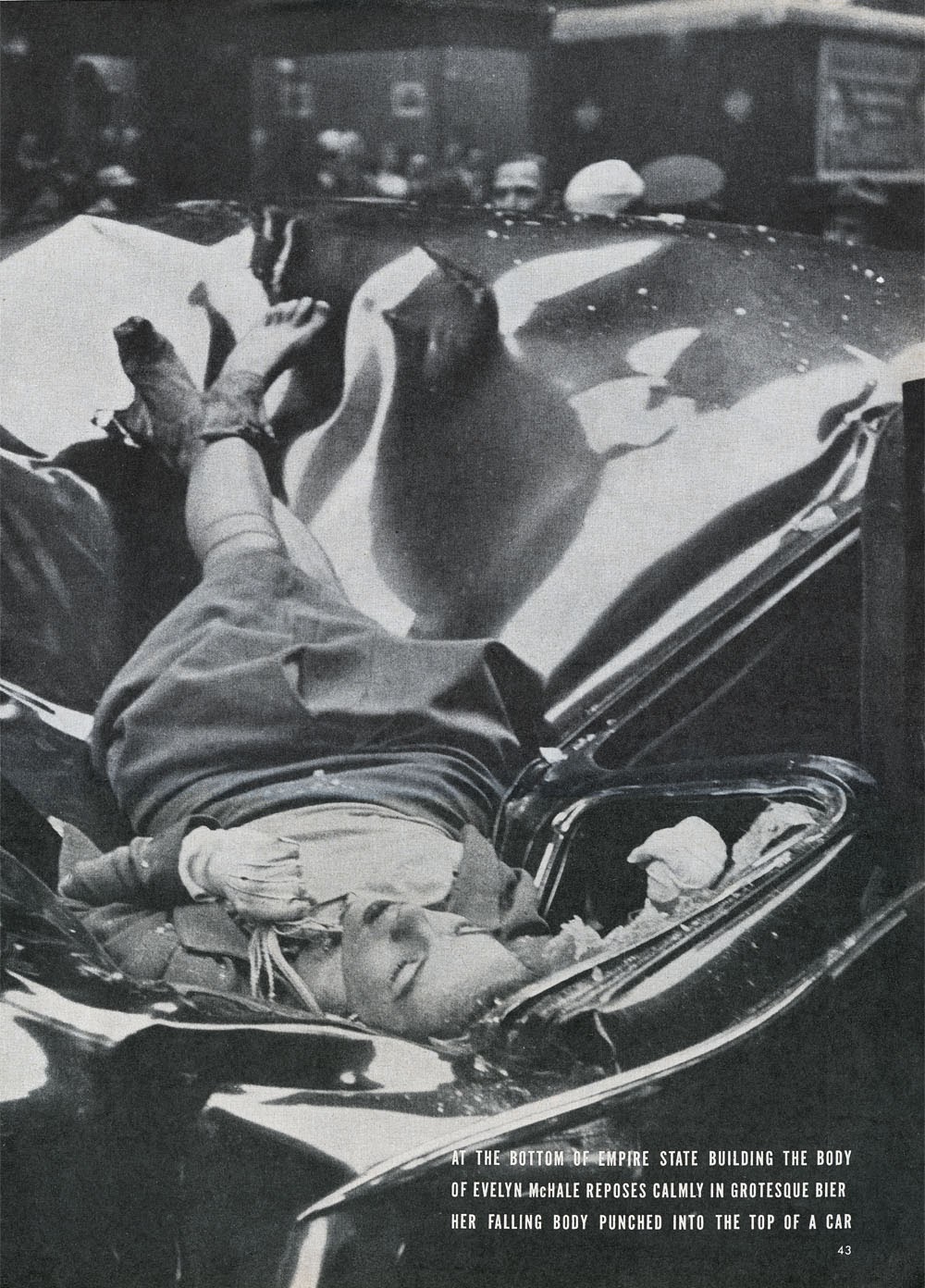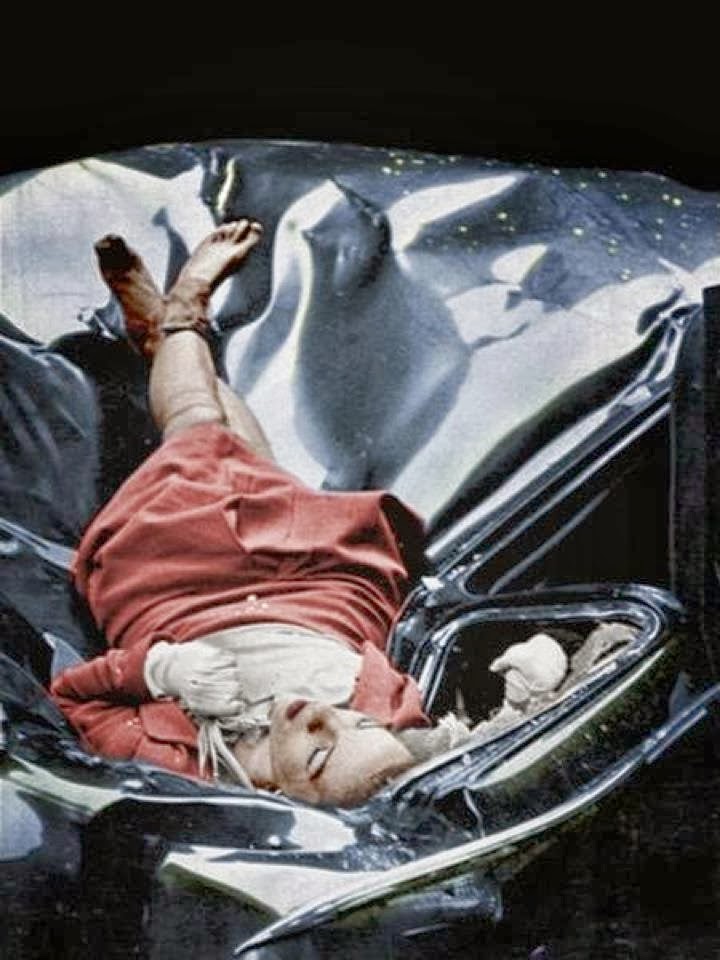It ran with the caption: “At the bottom of the Empire State Building the body of Evelyn McHale reposes calmly in grotesque bier, her falling body punched into the top of a car“. Evelyn McHale is probably the most famous Empire State Building suicide victim. The young and pretty Evelyn leaped from the 86th-floor observatory in 1947 and landed on the roof of a United Nations limousine parked on the street below. Her calmly elegant demeanor, her legs crossed at the ankles, the way the car’s metal folded like sheets and framed her head and arms—perhaps these were the reasons that McHale’s death was given its title as “The Most Beautiful Suicide”. When she died, she was still wearing her pearls and white gloves. Her last wish, according to the suicide note recovered by detectives beside the coat she had placed neatly over the railing of the 86th-floor Observation Deck, sent a chilling message. The note stated that no one in or out of her family would see any part of her. She wanted her body to be cremated immediately after it was discovered.
Who Was Evelyn McHale
Born September 20, 1923, was born in Berkeley, California, one of nine children born to Helen and Vincent McHale Her father was a bank examiner who relocated to Washington, D.C., in 1930. Her mother suffered from undiagnosed and untreated depression. This led to a challenging marriage and ultimately a divorce. Vincent gained custody of all children and moved to Tuckahoe, New York. After graduating from Normandy High School in 1942, Evelyn joined the Women’s Army Corps and was stationed in Jefferson City, Missouri. She later moved to Baldwin, New York, and was employed as a bookkeeper at the Kitab Engraving Company on Pearl Street. She met her fiancé Barry Rhodes, a Pennsylvania college student just discharged from the Air Force and was a bridesmaid at the wedding of Rhodes’s younger brother.
The Story Behind Evelyn McHale’s Death that was Dubbed “The Most Beautiful Suicide” by the Media
On April 30, 1947, Evelyn took the train from New York to Easton to visit Barry for his 24th birthday. All seemed well between the couple and the next day, Barry kissed his fiancé goodbye as she boarded the 7:00 AM train to Penn Station. “When I kissed her goodbye, she was happy and as normal as any girl about to be married”. Their wedding was set to be held at Barry’s brother’s home in Troy, New York, that June. Around 10:40 am Patrolman John Morrissey, directing traffic at Thirty-fourth Street and Fifth Avenue, noticed a white scarf floating down from the upper floors of the building. Moments later he heard a crash and saw a crowd converge on 34th Street. Evelyn had jumped, cleared the setbacks, and landed on the roof of a United Nations Assembly Cadillac limousine parked on 34th Street, some 200 ft west of Fifth Avenue. A photography student across the street, Robert C. Wiles, heard the loud crash of her body hitting the metal, and ran over too. Fortuitously, he had his camera and took a photo of her as she lay on the roof of the crumpled car. It was snapped just four minutes after she died and, despite the 1050-foot fall (320 m), her body looked intact. Remarkably Evelyn shows absolutely no evidence of trauma and appears disarmingly placid and composed – as if asleep. Around her, however, the crumpled sheet metal and broken glass show the violent destructive evidence of her jump. This apparent juxtaposition is what makes Wiles’ image so arresting and memorable. Some 75 years later it remains a haunting and affecting piece of photo-journalism. A common misconception is that her feet were bound–but in fact, she was wearing stockings and her feet happened to cross just before touchdown. Her gloved left hand was resting on her chest, holding firmly to her pearl necklace. According to reports she essentially “fell apart” when they moved her body. Her insides were basically liquefied.
Why Did Evelyn Kill Herself?
When police arrived at the 1,050-foot-high observation deck of the building, they found a neatly folded coat and a small handbag placed off to the side of the railing, along with a collection of family photos and a small notebook that contained her goodbye note, with the note which read: “I don’t want anyone in or out of my family to see any part of me. Could you destroy my body by cremation? I beg of you and my family – don’t have any service for me or remembrance for me. My fiance asked me to marry him in June. I don’t think I would make a good wife for anybody. He is much better off without me. Tell my father, I have too many of my mother’s tendencies”. Unfortunately, her desire to disappear from this world unseen was hardly attained, as the image of her body has become one of the most widely recognized – and perhaps romanticized – pictures of suicide to date. Her fiancé Rhodes did not notice any indication of suicidal thoughts before McHale left. Her body was identified by her sister, Helen Brenner. In accordance with her wishes, McHale was cremated with no memorial, service, or grave. Barry Rhodes became an engineer before moving south. He died unmarried in Melbourne, Florida, on October 9, 2007.
The Aftermath
Since the Empire State Building was constructed in 1931 some 36 people have jumped from the building, including 17 from the 86th-floor observation deck. However, due to the building’s unique design, many people do not reach the ground level and are instead caught by the setbacks tracing the perimeter. In 1947, Evelyn was the 6th person to have reached the bottom of the building, though a total of 12 had tried. In the three weeks leading up to Evelyn’s death, four other people had attempted suicide from the top of the building, and, as a result, a 10-foot-wide wire mesh blockade was put in place to deter jumpers. After the barrier was installed people just jumped from other parts of the building, usually from office windows. (Photo credit: Robert C. Wiles / Wikimedia Commons) Notify me of new posts by email.
Δ Subscribe








